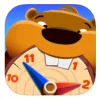Take a look inside 5 images
Tic Toc Time: Break down the day to learn how to tell time
Pros: A creative look at how the sun and shadows help us figure out the time of day.
Cons: The focus is relatively narrow; there are lots of opportunities to extend learning and better connect concepts with practical skills.
Bottom Line: A fun look into the concept of time, with concrete strategies to help kids understand an abstract idea.
Teachers can use Tic Toc Time for individual play or for learning in small groups. The app gives teachers a great opportunity to talk about using shadows to estimate the time of day. Teachers can make these abstract concepts come alive by performing an experiment: Take kids outside to trace their shadows, standing in exactly the same spot in the morning and the afternoon. The app can help kids answer the question of why and how their shadows move throughout the day. The clock games may align well to some math units, but teachers will want to support students as they work through some of the more challenging vocabulary.
In Tic Toc Time, a cute Canadian beaver family guides kids through an exploration of sunlight and shadow to tell time. Kids can also learn about telling time on different clocks. There are six "lessons," each building on the last, and the upper levels within each lesson are locked until kids complete the first game.
Kids first learn about the cardinal directions and how the sun's position in the sky changes throughout the day. They'll move on to learn about how we can tell time be looking at shadows and how to construct an analog clock. They'll also learn clock-reading skills with some relevant vocabulary. In the grown-ups section of the app, adults can choose from 10 languages, set up multiple accounts, or choose between a 12-hour or 24-hour clock format.
The games in Tic Toc Time follow a sequence; some of the games, though perhaps not all, may be fun enough to keep students engaged. The games exploring the sun's position and the resulting shadows are the best in a number of ways. Using a compass to discover the cardinal directions and, subsequently, the length and position of shadows, is a really creative way to introduce kids to the concept of the Earth's rotation as it relates to time-telling. There's also a brief explanation that connects these games to constructing a clock. These are interesting and concrete ways to help students conceptualize abstract ideas that affect them every day.
While the clock-based games are more straightforward, they have fewer in-game supports for finding correct answers, and they include some challenging vocabulary that might be a bit much for younger students. The sparse explanation of the big hand and little hand might work for older kids while confusing the younger set. Some of the inconsistencies between telling time on digital and analog clocks may also be confusing, and the app would do well to include more support with this. Nevertheless, Tic Toc Time is a solid resource for helping students understand the concepts behind why we tell time the way we do.












